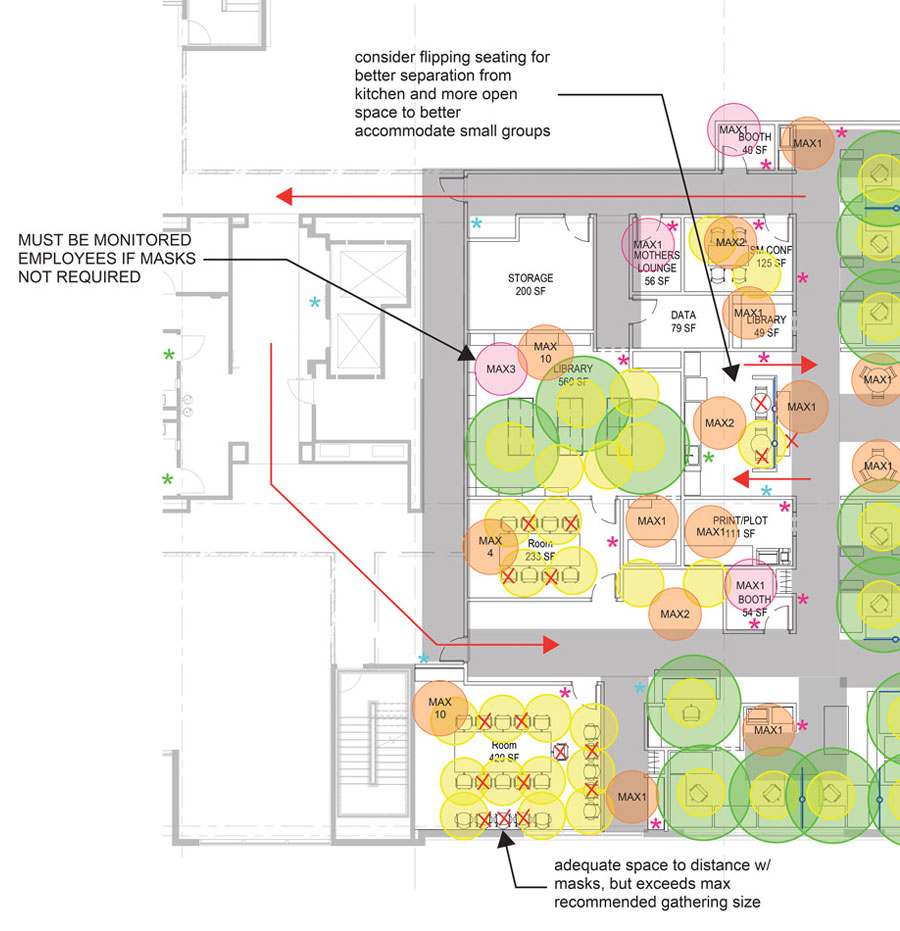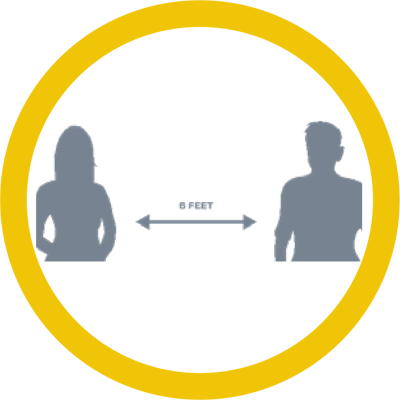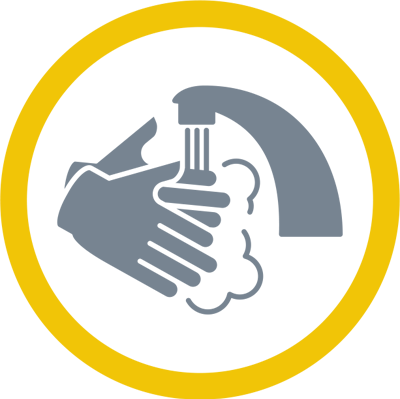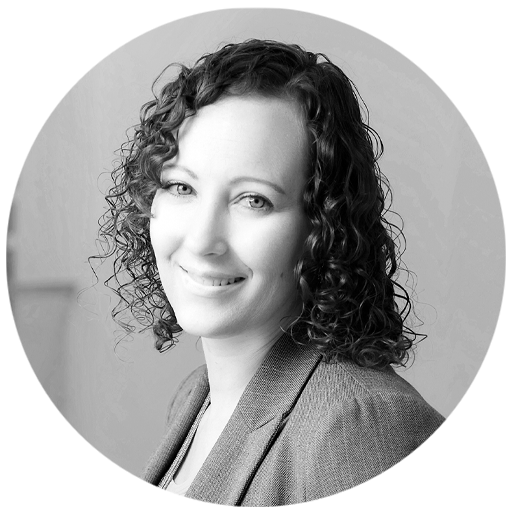Beyond a Pandemic
he built environment and the ways we use spaces will be forever changed by the COVID-19 pandemic. The design community is working as quickly as we can to research, respond and guide the world through this complete pivot in the places where we live, work and play. Something akin to designing and building a plane while flying it full of passengers. The goal: Change the course of this pandemic through design, create healthier spaces that improve human outcomes, help communities thrive, and return the economy to its former glory. Easy, right?
In a recent Inc. Real Talk interview series, I heard two of today’s most transformational CEOs and innovators stumble over this question: “What are you doing about your physical spaces in a post-COVID world?” For those who have poured their creativity and hundreds of millions of dollars into some of the world’s most innovative, open-concept collaboration spaces and iconic commercial spaces (think of your favorite tech or retail stores)—places meant for gathering—they seemed at a loss for the right answer.
Even my own small 37-person design company was faced with this same question, needing a plan for bringing our employees back to work safely. Regardless of country and industry, and no matter how big or small an organization, we find ourselves navigating what feels like the moving staircases at Hogwarts in the Harry Potter series. The scientific findings and conditions shift almost daily, leaving leaders wondering how to prepare for where the path might lead next.
“In recent months,” wrote Kyle Chayka in his article, “How the Coronavirus Will Reshape Architecture” in The New Yorker, “we have arrived at a new juncture of disease and architecture, where fear of contamination again controls what kinds of spaces we want to be in. As tuberculosis shaped modernism, so COVID-19…will influence architecture’s near future.”
Designers face a monumental task and opportunity to help us all pivot and improve how and where we do business. Thinking outside the box is a gross understatement of the innovation currently happening in the industry. I see designers doing what they do best. It’s not about the aesthetic; it’s about improving lives.
Strange as it sounds, there is a heightened level of excitement among many designers who thrive on challenge and societal shift. This is the design industry’s moment.
Design firms solve problems for people. Many designers have told me they aim to change the world through their craft. Balancing science with art, the best design firms today are agile and asking a lot of questions about values, pain points, vision and barriers. They’re working to remove those barriers and incorporate organizational values through good design.
A global pandemic is perhaps a larger barrier than any of us anticipated having to address in our lifetime. So how do we solve this problem? Research, peer groups, global task forces, copious amounts of reading, surveys, connecting with scientists and medical professionals, and technology are the foundation. To create actionable ways to help business leaders, we are looking inward and asking ourselves the tough questions this time. What is most important to us going forward? What are our pain points? Where do we get stuck? How can we work differently?
The design industry focus has rapidly shifted. In March: “How do we help healthcare organizations respond immediately to care for COVID patients?” Today: “How do we help leaders in every industry across the globe safely and economically navigate reopening?”
Before we spend time and money completely overhauling our spaces, the first step is to consider a more reflective, long-term look at working and operating differently, innovating our practices, becoming more efficient, and embracing technology and the virtual worker (and customer) in a new way.
Never have I seen facilities design and management and human resources quite so interconnected.
Thomas Showalter of AleraConnect HR articulated this well: “Progressive employers are recognizing that workforce and worksite are more extricable now than ever… Physical worksites will continue to be an essential part of many employers’ operations, but likewise are undergoing transformations. With employee, customer, and community safety paramount, employers are having to rethink their worksites from store fronts, to restaurants, factory floors, and offices. Those who develop comprehensive strategies that consider workforces and worksites together will be better adapted to survive and thrive during COVID and beyond.”
In my company, #WFH (Work from Home) has revealed incredible productivity and the once-mythical work-life balance for many. We can broaden our recruitment pool, national design collaborations and business development opportunities, and find new ways to keep good employees with the flexibility to work anywhere.

I am an incurable optimist, but there is opportunity to grow in any situation. Those businesses that are not innovating and finding opportunities to change and grow right now may not exist on the other side of this global pandemic. This means examining every part of how we operate our businesses, including our physical space.
From the multinational corporation to the small business, companies of all sizes are asking if walls are even necessary, how they will work in the future, how much real estate they really need, how they can consolidate space and allow for more hotel-type or temporary workstations for short-term office stays rather than permanent desks.
As Anne Zink, the State of Alaska’s Chief Medical Officer, said, “Regarding offices – I think the more you can work from home, the healthier your employees will be and the more you will be able to stay open. If there are some who really need the office, then at least it is there for them with less people.” (Anchorage Rotary presentation, June 16, 2020.)
Healthy, Resilient Spaces = Healthy, Resilient People. For years, designers have studied and promoted the idea that human spaces and environments—good or bad—can have a significant impact on outcomes and the ability to thrive.
On a recent elementary school project, for example, I was fascinated to listen to the engineers discuss air circulation systems that reduce the spread of airborne illnesses in classrooms, thereby reducing the number of sick days, improving attendance, and in turn improving grades and student outcomes.
This ripple effect is a common design theme, and we can and should maximize the butterfly effect and design adaptable buildings that garner the most positive long-term outcomes.
“Right now, what humans want most is safety, the foundation of Maslow’s hierarchy of needs,” Kay Sargent, HOK director of global WorkPlace practice, wrote on WSP.com (“Will Physical Distancing Be the End of the Office?”).
As the world reopens, our spaces must first make people feel safe. Beyond that, mixing policy, science and medical research with design will yield healthy, productive environments and positive human experiences.
One organization that is dedicated to healthy spaces is the International WELL Building Institute, which created the International WELL Building Institute Task Force on COVID-19 and Other Respiratory Infections: Prevention and Preparedness, Resilience and Recovery. Alaska-based interior designer Dana Nunn, a colleague and member of this task force, reminded me that this conversation is not about COVID-19; it’s about creating the healthiest human spaces possible for long-term benefits. It’s about being intentional about our spaces, balancing thoughtful space design with operations and human resources expertise to achieve wellness.

- Modify office layout for social distancing
- Create opportunities for social connection with physical distancing
- Communicate your plans with employees, clients, and customers to instill confidence and comfort in coming together
- Provide training and clear signage that encourages safe, healthy habits

- Lead with empathy
- Provide access/views to nature
- Provide access to natural light with glare control
- Encourage proactive stress management

- Cultivate a culture of health
- Promote healthy eating habits
- Encourage physical activity
- Promote healthy sleep habits

- Support local communities
- Foster community connections
- Prepare for emergencies
- Be informed by evidence
- Review and update organizational policies

- Supply convenient hand-hygiene amenities
- Eliminate clutter and maintain tidy spaces
- Implement cleaning protocols using safe and effective products
- Use finishes and furniture that can handle rigorous cleaning
- Install sneeze and cough guards at service counters

- Increase natural and mechanical ventilation
- Maintain clean and effective air filtration
- Manage moisture to minimize mold and microbes
- Integrate advanced filtration and disinfection technologies

- Provide supportive and adjustable furnishings
- Offer ergonomic work tools
- Encourage self-monitoring and frequent workstation adjustments

- Create outdoor work and gathering spaces
- Provide heat and/or shade
- Provide comfortable seating options
- Provide access to fresh air
- Promote outdoor activities
A healthy space is not just about infection prevention. Our space (or lack thereof) helps maintain corporate cultures. For companies like mine, collaborative, open practice based on collective creativity, and focused on integrative design and team innovation, are not easy to replicate from a Zoom screen.
While many companies are thriving in the virtual world, as the remote days turn to weeks and months we feel the void left when we remove human connection both personally and professionally. Lack of human engagement is a serious wellness concern. For some, struggles with isolation and depression have reached the tipping point, reminding us that taking care of the whole person is critical.
In my own company, many have thrived, but some need to get back to the workplace for their wellbeing and mental health. A design-meets-HR approach—creating alternating schedules, staggering desk spaces, moving circulation pathways, converting conference rooms to offices, and implementing medical-inspired cleaning and PPE protocols—allow for some to return to work and thrive again with some sense of normalcy and connectedness. Of course, this is easy for a 37-person company, but it is mind-bending to think about caring for staff in such a personalized way in a company of thousands or tens of thousands. But we can design a solution, and we must.
The crystal ball is fuzzy for now, but I imagine a future with a hybrid approach that allows us to create new ways of engaging with our customers and the public, personalize our work environments, care for each other, optimize our potential to do our best work, and yes, change the world through design.
Dr. Zink once again said it best: “Are we going to do something different as a society? My hope is that this will help us all see how amazingly interconnected we are. This virus is showing us these individual and invisible connections between us that we don’t always see but are always a part of our lives and the ways that we all interface and interact with each other, and how one person’s decisions really do affect someone else’s decisions. And so, my hope is that we can become more resilient as communities and that we find ways to better collectively care for each other.”
https://www.nytimes.com/2020/04/07/business/workplace-telecommuting-coronavirus.html
https://www.workdesign.com/2020/05/healthy-buildings-how-architecture-can-defend-us-from-covid-19/
https://perkinswill.com/road-map-for-return/
https://hga.com/experiencing-covid-19-coronavirus-through-the-design-lens/
https://www.hok.com/covid-19-design-for-change/
https://www.gensler.com/design-responds-to-a-changing-world
https://www.metropolismag.com/interiors/workplace-interiors/upali-nada-hks-wellness/
